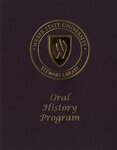| Title |
Fain, Jim OH15_003 |
| Creator |
Weber State University, Stewart Library: Oral History Program |
| Contributors |
Fain, Jim, Interviewee; Rands, Lorrie, Interviewer |
| Collection Name |
Utah Cowboy and Western Heritage Museum Oral Histories |
| Description |
The Utah Cowboy and Western Heritage Museum honors men and women whose lives exemplify the independence and resilience of the people who settled Utah, and includes artists, champions, entertainers, musicians, ranchers, writers, and those persons, past and present, who have promoted the Western way of life. Each year, the inductees are interviewed about their lives and experiences living the Western way of life. |
| Abstract |
The following includes the transcript and a video clip from an oral history interview with Jim Fain. |
| Relation |
https://library.weber.edu/collections/oral_history |
| Image Captions |
Jim Fain |
| Subject |
Rodeos; Cowboys; Photography |
| Digital Publisher |
Stewart Library, Weber State University, Ogden, Utah, USA |
| Date |
2014 |
| Date Digital |
2018 |
| Temporal Coverage |
1942; 1943; 1944; 1945; 1946; 1947; 1948; 1949; 1950; 1951; 1952; 1953; 1954; 1955; 1956; 1957; 1958; 1959; 1960; 1961; 1962; 1963; 1964; 1965; 1966; 1967; 1968; 1969; 1970; 1971; 1972; 1973; 1974; 1975; 1976; 1977; 1978; 1979; 1980; 1981; 1982; 1983; 1984; 1985; 1986; 1987; 1988; 1989; 1990; 1991; 1992; 1993; 1994; 1995; 1996; 1997; 1998; 1999; 2000; 2001; 2002; 2003; 2004; 2005; 2006; 2007; 2008; 2009; 2010; 2011; 2012; 2013; 2014 |
| Item Size |
59p.; 29cm.; 2 bound transcripts; 4 file folders. 1 video disc: digital; 4 3/4 in. |
| Medium |
oral histories (literary genre) |
| Spatial Coverage |
Phoenix, Maricopa County, Arizona, United States, https://sws.geonames.org/5308655; Golden, Jefferson County, Colorado, United States, https://sws.geonames.org/5423294; Grand Canyon, Mohave County, Arizona, United States, https://sws.geonames.org/5296392; Utah, United States, https://sws.geonames.org/5549030 |
| Type |
Text; Image/MovingImage |
| Conversion Specifications |
Filmed using a Sony HDR-CX400. Transcribed with Express Scribe. Digitally reformatted using Adobe Acrobat XI Pro. |
| Language |
eng |
| Rights |
Materials may be used for non-profit and educational purposes, please credit University Archives, Stewart Library; Weber State University. |
| Source |
Fain, Jim OH15_003; Weber State University, Stewart Library, University Archives |
| Format |
application/pdf; video/mp4 |
| ARK |
ark:/87278/s6qfyvv9 |
| Setname |
wsu_webda_oh |
| ID |
104219 |
| Reference URL |
https://digital.weber.edu/ark:/87278/s6qfyvv9 |
| Title |
Fain, Jim OH15_003 |
| Creator |
Weber State University, Stewart Library: Oral History Program |
| Contributors |
Fain, Jim, Interviewee; Rands, Lorrie, Interviewer |
| Description |
The Utah Cowboy and Western Heritage Museum honors men and women whose lives exemplify the independence and resilience of the people who settled Utah, and includes artists, champions, entertainers, musicians, ranchers, writers, and those persons, past and present, who have promoted the Western way of life. Each year, the inductees are interviewed about their lives and experiences living the Western way of life. |
| Relation |
https://library.weber.edu/collections/oral_history |
| Image Captions |
Jim Fain |
| Biographical/Historical Note |
The following is an oral history interview with Jim Fain. The interview was conducted on June 5, 2014, by Lorrie Rands. Woodrow Johnson is on Camera. Jim discusses being inducted into the cowboy hall of fame, and some of his memories. His wife, Karen, is also present during the interview. |
| Subject |
Rodeos; Cowboys; Photography |
| Digital Publisher |
Stewart Library, Weber State University, Ogden, Utah, USA |
| Date |
2014 |
| Date Digital |
2018 |
| Temporal Coverage |
1942-2014 |
| Item Size |
59p.; 29cm.; 2 bound transcripts; 4 file folders. 1 video disc: digital; 4 3/4 in. |
| Medium |
oral histories (literary genre) |
| Spatial Coverage |
Phoenix, Maricopa County, Arizona, United States, https://sws.geonames.org/5308655; Golden, Jefferson County, Colorado, United States, https://sws.geonames.org/5423294; Grand Canyon, Mohave County, Arizona, United States, https://sws.geonames.org/5296392; Utah, United States, https://sws.geonames.org/5549030 |
| Type |
Text; Image/MovingImage |
| Conversion Specifications |
Filmed using a Sony HDR-CX400. Transcribed with Express Scribe. Digitally reformatted using Adobe Acrobat XI Pro. |
| Language |
eng |
| Rights |
Materials may be used for non-profit and educational purposes, please credit University Archives, Stewart Library; Weber State University. |
| Source |
Fain, Jim OH15_003; Weber State University, Stewart Library, University Archives |
| Format |
application/pdf |
| Setname |
wsu_webda_oh |
| ID |
104417 |
| Reference URL |
https://digital.weber.edu/ark:/87278/s6qfyvv9/104417 |





